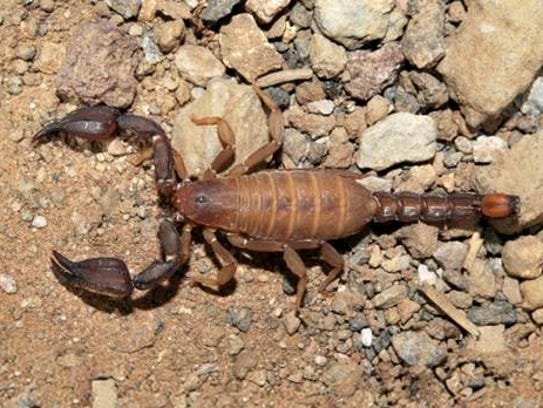Luke Skywalker
Super Moderator
{vb:raw ozzmodz_postquote}:
A male P. santarita scorpion found in Madera Canyon.(Photo: Courtesy Richard Ayrey)
PHOENIX — As if there weren’t enough scorpions in the world, two new species have been found in southeastern Arizona by those who leave no stone unturned-over in their ongoing quest to find venomous creatures.
One of the critters was discovered in the Santa Catalina Mountains, and the other in Madera Canyon in the Santa Rita Mountains, according to an article published in Euscorpius, a scientific journal dedicated to the study of creatures most people want to avoid.
THERE ARE MORE SCORPIONS OUT THERE
Before you get too excited (or nervous) about previously unknown scorpions, the two new species are closely related to a species first discovered back in 1972. So far, there's no indication that the creatures are evolving in grossly unanticipated ways in an attempt to dominate the planet or rise up the food chain.
So what does that mean to you? Well, mainly that there's more scorpions out there. And yes, they are still ugly.
USA TODAY
Rite of spring: Arizona sees spike in snake bites
The new species share the hallmarks of all scorpions, including pincers, stingers and ability to trigger the fight-or-flight reaction in any human. Each is roughly an inch long and incredibly intimidating for their sizes. It's unclear how dangerous its sting is.
MORE THAN 100 SPECIES OF SCORPIONS
There are more than 100 species of scorpions, and Arizona is a literal hotbed for stealthy creatures, which embrace the high temperatures. That comes as absolutely no surprise to anyone who has stumbled across, stepped on or otherwise encountered one in the urban and suburban wild (or bedroom). Most problematic scorpion stings are caused by the tiny bark scorpion, which are easily spotted (because they glow) with a black light.
Richard Ayrey and Michael Soleglad, who found the two new species, noticed the sorts of morphological differences that only a scorpiologist would look for and appreciate. According to the December 2015 article, the researchers found subtle biological distinctions indicating a new species, including but not limited to “the mating plug.”
Any non-scorpiologist who knows what that is, raise your hand.
Hmm. Thought so.
A female P. santarita scorpion found in Madera Canyon.<span style="color: Red;">*</span>(Photo: Courtesy Richard Ayrey)
Powered By WizardRSS.com | Full Text RSS Feed
